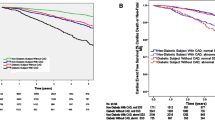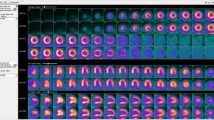Abstract
In the last five years, many studies have been performed to try to improve understanding of the clinical condition of syndrome X (anginal quality chest pain, ischemic-like changes on the stress ECG yet a normal coronary arteriogram). In this chapter, we review advances in knowledge of the pathophysiology of this condition which have been obtained by means of positron emission tomography (PET). The context in which the PET studies have been performed, i.e. several invasive studies and a number of non-PET nuclear cardiological investigations, is also outlined. Finally, we attempt to arrive at a conclusion more substantive than the somewhat vague and mysterious closing comments about a “heterogeneous disorder” with which many authors on the subject have taken leave of their readers.
Access this chapter
Tax calculation will be finalised at checkout
Purchases are for personal use only
Preview
Unable to display preview. Download preview PDF.
Similar content being viewed by others
References
Rose G, McCartney P, Reid DD. Self-administration of a questionnaire on chest pain and intermittent claudication. Br J Prevent Soc Med 1977; 31:42–48.
Green LH, Cohn PF, Holman BL, Adams DF, Markis JE. Regional myocardial blood flow in patients with chest pain syndromes and normal coronary arteriograms. Br Heart J 1978; 40: 242–249.
Opherk D, Zebe H, Weihe E, Mall G, Dtirr C, Gravert B, Mehmal HC, Schwartz F, Kubler W. Reduced coronary dilatory capacity and ultrastructural changes in the myocardium in patients with angina pectoris but normal coronary arteriograms. Circulation 1981; 63: 817–825.
Cannon RO, Schenke WH, Leon MB, Rosing DR, Urqhart J, Epstein SE. Limited coronary flow reserve after dipyridamole in patients with ergonovine-induced coronary vasoconstriction. Circulation 1987; 75: 163–174.
Crake T, Canepa-Anson R, Shapiro L, Poole-Wilson PA. Continuous reading of coronary sinus oxygen saturation during atrial pacing in patients with coronary artery disease or syndrome X. Br Heart J 1988; 59: 31–38.
Epstein SE, Cannon RO. Site of increased resistance to coronary flow in patients with angina pectoris and normal epicardial coronary arteries. J Am Coll Cardiol 1986; 8: 459–461.
Kemp HG, Elliott WC, Gorlin R. The anginal syndrome with normal coronary arteriography. Trans Assoc Am Physicians 1967; 80: 59–70.
Arbogast R, Bourassa MG. Myocardial function during atrial pacing in patients with angina pectoris and normal coronary arteriograms. Comparison with patients having significant coronary artery disease. Am J Cardiol 1973; 32:257–263.
Holdright DR. Chest pain with normal coronary arteries. Br J Hosp Med 1996; 56: 347–50.
Chauhan A, Mullins PA, Gill R, Taylor G, Petch MC, Schofield PM. Coronary flow reserve and oesophageal dysfunction in syndrome X. Postgrad Med J 1996; 72: 99–104.
Sanderson JE, Woo KS, Chung HK, Chan WW, Tse LK, White HD. The effect of transcutaneous electrical nerve stimulation on coronary and systemic haemodynamics in syndrome X. Coron Artery Dis 1996; 7: 547–52.
Chauhan A, Petch MC, Schofield PM. Cardio-oesophageal reflex in humans as a mechanism for “linked angina’ Eur Heart J 1996; 17: 407–13.
Chauhan A, Mullins PA, Petch MC, Schofield PM. Is coronary flow reserve in response to papaverine really normal in syndrome X? Circulation. 1994; 89: 1998–2004.
Holdright DR, Lindsay DC, Clarke D, Fox K, Poole-Wilson PA, Collins P. Coronary flow reserve in patients with chest pain and normal coronary arteries. Br Heart J. 1993; 70: 513–9.
Chauhan A, Mullins PA, Taylor G, Petch MC, Schofield PM. Effect of hyperventilation and mental stress on coronary blood flow in syndrome X. Br Heart J 1993; 69: 516–24.
Meeder JG, Blanksma PK, van der Wall EE, Willemsen AT, Pruim J; Anthonio RL, de Jong RM, Vaalburg W, Lie KI Coronary vasomotion in patients with syndrome X: evaluation with positron emission tomography and parametric myocardial perfusion imaging. Eur J Nucl Med. 1997; 24: 530–7.
Fragasso G, Rossetti E, Dosio F, Gianolli L, Pizzetti G, Cattaneo N, Fazio F, Chierchia SL. High prevalence of the thallium-201 reverse redistribution phenomenon in patients with syndrome. Eur Heart J 1996; 17: 1482–7.
Meeder JG, Blanksma PK, Crijns HJ, Anthonio RL, Pruim J, Brouwer J, de Jong RM, van der Wall EE, Vaalburg W, Lie KI. Mechanisms of angina pectoris in syndrome X assessed by myocardial perfusion dynamics and heart rate variability. Eur Heart J 1995; 16: 1571–7.
Inobe Y, Kugiyama K, Morita E, Kawano H, Okumura K, Tomiguchi S, Tsuji A, Kojima A, Takahashi M, Yasue H. Role of adenosine in pathogenesis of syndrome X: assessment with coronary hemodynamic measurements and thallium-201 myocardial single-photon emission computed tomography. J Am Coll Cardiol 1996; 28: 890–6.
Kao CH, Wang SJ, Ting CT, Chen YT.99mTc sestamibi myocardial SPECT in syndrome X. Clin Nucl Med 1996; 21: 280–3.
Palleschi L, Gianni W, De Vincentis G, Banci M, Sottosanti G, Ierardi M, Scopinaro F, Marigliano V. Dipyridamole technetium-99m Sestamibi imaging in the diagnosis of syndrome X. Angiology. 1996; 47: 369–73.
Kao CH, Wang SJ, Ting CT, Chen YT. Thallium-201 myocardial SPET in strictly defined syndrome X. Nucl Med Commun 1995; 16: 640–6.
Thorley PJ, Ball J, Sheard KL, Sivananthan UM. Evaluation of 99mTc-tetrofosmin as a myocardial perfusion agent in routine clinical use. Nucl Med Commun 1995; 16: 733–40.
Rosano GM, Peters NS, Kaski JC, Mavrogeni SI, Collins P, Underwood SR, Poole-Wilson PA. Abnormal uptake and washout of thallium-201 in patients with syndrome X and normal-appearing scans. Am J Cardiol 1995; 75: 400–2.
Rosen SD, Uren NG, Kaski J-C, Tousoulis D, Davies GJ, Camici PG. Coronary Vasodilator Reserve, Pain Perception and Gender in Patients with Syndrome X. Circulation 1994; 90: 50–60.
Galassi AR, Crea F, Araujo LI, Lammertsma AA, Pupita G, Yamomoto Y, Rechavia E, Jones T, Kaski J-C, Maseri A. Comparison of regional myocardial blood flow in syndrome X and one-vessel coronary artery disease. Am J Cardiol 1993; 72: 134–139.
Tweddel AC, Martin W, Hutton I. Thallium scans in syndrome X. Br Heart J 1992; 68: 48–50.
Rosen SD, Camici PG. Syndrome X: radionuclide studies of myocardial perfusion in patients with chest pain and normal coronary arteriograms [editorial] Eur J Nucl Med 1992; 19: 311–4.
Geltman EM, Henes CG, Sennef MJ, Sobel BE, Bergman SR. Increased myocardial perfusion at rest and diminished perfusion reserve in patients with angina and angiographically normal coronary arteries. J Am Coll Cardiol 1990; 16: 586–595.
Camici PG, Gistri R, Lorenzoni R, Sorace O, Michelassi C, Bongiomi MG, Salvadori PA, L’Abbate A. Coronary reserve and exercise ECG in patients with chest pain and normal coronary angiograms. Circulation 1992; 86: 179–186.
Galassi AR, Kaski J-C, Pupita G, Vejar M, Crea F, Maseri A. Lack of evidence for alpha-adrenergic receptor-mediated mechanisms in the genesis of ischemia in syndrome X. Am J Cardiol 1989; 64: 264–269.
Lorenzoni R, Rosen SD, Camici PG. Effect of selective a, blockade on resting and hyperemic myocardial blood flow in normal humans. Am J Physiol 1996; 271: H1302–H1306.
Camici PG, Rosen SD. Does positron emission tomography contribute to the management of clinical cardiac problems? Eur Heart J 1996; 17: 174–181.
Baig MW, Sheard K, Thorley PJ, Rees MR, Tan LB. The use of dobutamine stress thallium scintigraphy in the diagnosis of syndrome X. Postgrad Med J 1992; 68 Suppl 2: S20–4.
Kataoka T, Shih WJ. False-positive myocardial perfusion scintigraphy in syndrome X. Semin-NuclMed. 1997; 27: 186–9.
Uren NG, Camici PG, Melin JA, Bol A, de Bruyne B, Radvan J, Olivotto I, Rosen SD, Impallomeni M and Wijns W. The effect of ageing on the coronary vasodilator reserve in man. J Nucl Med 1995; 36: 2032–2036.
Hoffman JIE. Heterogeneity of myocardial blood flow. Bas Res Cardiol 1995; 90: 103–111.
Rosen SD, Boyd H, Lorenzoni R, Kaski J-C, Camici PG. Effects of a1 blockade on myocardial blood flow in patients with cardiac syndrome X. Circulation 1997; 96: I-625.
Nihoyannopoulos P, Kaski JC, Crake T, Maseri A. Absence of myocardial dysfunction during pacing stress in patients with syndrome X. J Am Coll Cardiol 1991;18:1463–1470.
Camici PG, Marraccini P, Lorenzoni R, Buzzigoli G, Pecori N, Perissinotto A, Ferrannini E, L’Abbate A, Marzilli M: Coronary hemodynamics and myocardial metabolism in patients with syndrome X: response to pacing stress. J Am Coll Cardiol 1991;17:1461–1470.
Panza JA, Laurienzo JM, Curiel RV, Unger EF, Quyyumi AA, Dilsizian V, Cannon RO. Investigation of the mechanism of chest pain in patients with angiographically normal coronary arteries using transesophageal dobutamine stress echocardiography. J Am Coll Cardiol 1997; 29: 293–301.
Rosano GM, Kaski JC, Arie S, Pereira WI, Horta P, Collins P, Pileggi F, Poole-Wilson PA. Failure to demonstrate myocardial ischemia in patients with angina and normal coronary arteries. Evaluation by continuous coronary sinus pH monitoring and lactate metabolism. Eur Heart J 1996; 17: 1175–80.
Shapiro LM, Crake T, Poole-Wilson PA. Is altered cardiac sensation responsible for chest pain in patients with normal coronary arteries? Clinical observation during cardiac catheterization. Br Med J 1988; 296: 170–171.
Cannon RO, Quyyumi AA, Schenke WH, Fananapazir L, Tucker EE, Gaughan AM, Gracely RH, Cattau EL, Epstein SE. Abnormal cardiac sensitivity in patients with chest pain and normal coronary arteries. J Am Coll Cardiol 1990; 16: 1359–1366.
Eriksson B, Svedenhag J, Martinsson A, Sylvén C. Effect of epinephrine infusion on chest pain in syndrome X in the absence of signs of myocardial ischemia. Am J Cardiol. 1995; 75: 241–245.
Turiel M, Galassi AR, Glazier JJ, Kaski JC, Maseri A: Pain threshold and tolerance in women with syndrome X and women with stable angina pectoris. Am J Cardiol 1987; 60:503–507.
Rosen SD, Paulesu E, Frith CD, Jones T, Davies GJ, Frackowiak RSJ, Camici PG. Central neural correlates of angina pectoris as a model of visceral pain. Lancet 1994; 344: 147–150.
Rosen SD, Paulesu E, Nihoyannopoulos P, Tousoulis D, Frackowiak RSJ, Frith CD, Jones T and Camici PG. Silent ischemia as a central problem: regional brain activation compared in silent and painful myocardial ischemia. Ann Int Med 1996; 124: 939–949.
Raichle M. Circulatory and metabolic correlates of brain function in normal humans In: Mountcastle VB, Plum F, Geiger SR eds. Handbook of Physiology. Section 1: The nervous system. Vol V Higher functions of the brain Part 2, Chapter 16. Bethesda Md, USA: American Physiological Society, 1987: 643–674.
Friston KJ, Frackowiak RSJ. Imaging functional anatomy. In: Lassen NA. Ingvar DH, Raichle ME, Friberg L eds. Brain work and mental activity, Alfred Benzon symposium vol 31, Copenhagen, Munksgaard 1991: 267–279.
Rosen SD, Paulesu E, Frackowiak RSJ, Camici PG. Regional Brain Activation Compared in Angina Pectoris and Syndrome X. Circulation 1995; 92: 1–651.
Cannon RO, Quyyumi AA, Mincemoyer R, Stine AM, Gracely RH, Smith WB, Geraci MF, Black BC, Uhde TW, Waclawiw MA, et al. Imipramine in patients with chest pain despite normal coronary angiograms. N Engl J Med 1994; 330: 1411–7.
Cannon RO. The sensitive heart. A syndrome of abnormal cardiac pain perception [clinical conference] J Am Med Assoc 1995; 273: 883–7.
Marcus ML, Wilson RF, White CW. Methods of measurement of myocardial blood flow in patients: A critical review. Circulation 1987; 76: 245–53.
Camici PG, Marraccini P, Gistri R, Salvadori PA, Sorace O, L’Abbate A. Adrenergically mediated coronary vasoconstriction in patients with syndrome X. Cardiovasc Drugs Ther. 1994; 8: 221–6.
Editor information
Editors and Affiliations
Rights and permissions
Copyright information
© 1999 Springer Science+Business Media New York
About this chapter
Cite this chapter
Rosen, S.D., Camici, P.G. (1999). Insights into the Pathophysiology of Syndrome X Obtained Using Positron Emission Tomography (PET). In: Kaski, J.C. (eds) Chest Pain with Normal Coronary Angiograms: Pathogenesis, Diagnosis and Management. Developments in Cardiovascular Medicine, vol 213. Springer, Boston, MA. https://doi.org/10.1007/978-1-4615-5181-2_6
Download citation
DOI: https://doi.org/10.1007/978-1-4615-5181-2_6
Publisher Name: Springer, Boston, MA
Print ISBN: 978-1-4613-7360-5
Online ISBN: 978-1-4615-5181-2
eBook Packages: Springer Book Archive




